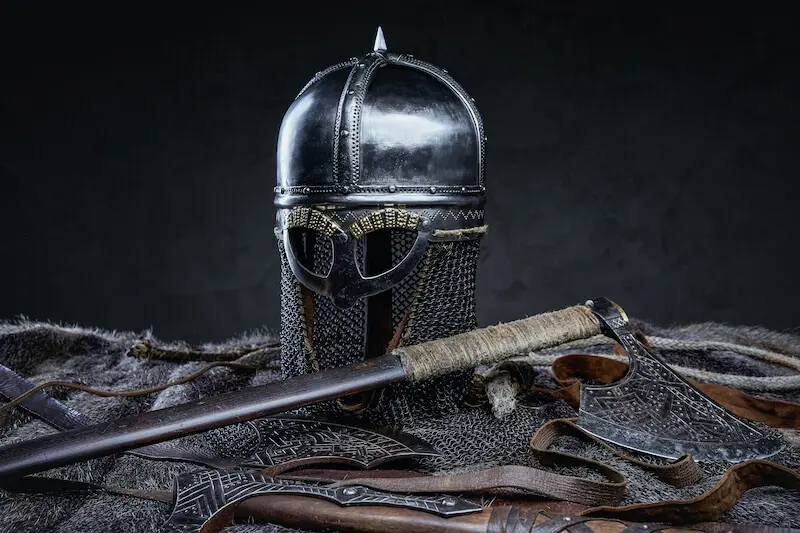The Historical Use of Axes: More Than Just Tools
Introduction The Historical Use of Axes
Axes have been pivotal to human development, shaping the course of civilizations for thousands of years. What began as a simple hand tool has evolved into a symbol of strength, authority, and culture across various societies. While axes were first designed for survival, their significance goes far beyond cutting down trees or splitting logs. This blog explores the historical, cultural, and symbolic importance of axes, from prehistoric times to their modern-day uses.
Prehistoric Beginnings: The Survival Tool
The story of the axe begins with early humans. Around 1.5 million years ago, some of the earliest axes were hand-axes made from stone, dating back to the Acheulean period of the Lower Paleolithic era. These stone tools were simple yet effective, used for cutting, hunting, and digging.
- Tool for Survival: Early axes allowed humans to manipulate their environment, increasing their ability to hunt and gather food. Sharpened edges could slice through animal hides, carve wood, and prepare meat. As a result, axes became a critical survival tool during the Stone Age.
- Craftsmanship Evolution: As tool-making skills advanced, so did the complexity of axes. The Neolithic era saw the development of polished stone axes, which were more efficient and durable. These advancements allowed for better control over agriculture, clearing forests to plant crops, and creating better shelters.
Axes in Ancient Civilizations: Function Meets Symbolism
As societies grew more complex, axes took on broader roles beyond their practical applications.
- Symbol of Power and Authority: In many early civilizations, axes became emblems of leadership and strength. For example:
- Egyptians: In ancient Egypt, the double-headed axe (known as the Labrys) was often depicted in artwork, symbolizing divine authority and kingship.
- Minoan Culture: In the Minoan civilization of Crete, the Labrys symbolized power and protection, frequently associated with rituals and worship.
- Axes in Rituals and Mythology: The axe also became associated with religious and mythological imagery.
- Viking Mythology: In Norse mythology, the god Thor’s hammer, Mjölnir, was sometimes depicted as an axe, representing divine power and protection. Viking warriors, known for their fearsome battle skills, often used axes not only as weapons but also in ceremonial practices.
- Greek Mythology: The double-headed axe was a sacred symbol of Zeus, often used in rituals of thunder and lightning worship. It also represented the duality of life and death, a balance of destructive and creative forces.

The Axe as a Weapon of War
The Historical Use of Axes became essential tools in warfare, gaining prominence on battlefields across Europe, Asia, and beyond.
- The Viking Axe: The Viking bearded axe, so named for the distinctive shape of its lower blade, became iconic during the Viking Age (793–1066 AD). Unlike swords, axes were cheaper and easier to produce, making them accessible to all warriors. However, they were just as deadly. The long-handled battle axe could be used for swinging or throwing, allowing the Vikings to devastate their enemies with brute force and precision.
- Medieval Europe: Throughout the medieval period, axes remained widely used as weapons. The Danish axe, a large, two-handed weapon, was a favorite of Anglo-Saxon housecarls (elite warriors). Its heavy, long blade could cleave through armor, making it a formidable battlefield weapon.
- Symbol of Rank and Prestige: Many elite warriors or knights carried axes as a sign of their status. These weapons were often elaborately designed, adorned with precious metals or intricate engravings, showcasing both the skill of the craftsman and the rank of the bearer. Axes like these could be symbols of authority, similar to the ceremonial maces used in various courts and parliaments.
The Axe as a Crafting Tool: Shaping Human Progress
Despite their association with warfare, axes have always had strong ties to craftsmanship and daily labor.
- Woodworking and Agriculture: With the advent of the Bronze Age and later the Iron Age, axes became more specialized. Carpenters used axes to create everything from homes to furniture, while farmers relied on them to clear land for cultivation.
- The felling axe, used to chop down trees, became vital in expanding human settlements and agriculture.
- The broad axe was used by craftsmen to hew logs into square beams, essential for building structures such as homes, ships, and bridges.
- The Artisan’s Tool: Over time, axes became more refined, with specific designs emerging for particular tasks. The double-bit axe, featuring two cutting edges, was commonly used by lumberjacks, one edge for chopping and the other for splitting logs. This efficiency led to the development of new industries such as logging, which transformed landscapes and economies in various parts of the world.
Modern Symbolism and Cultural Significance
While technology has replaced the traditional axe in many practical contexts, the symbolism of the axe persists.
- The Historical Use of Axes as a Symbol of Freedom and Rebellion: In American history, the axe came to symbolize independence and frontier spirit. Pioneers carried axes westward as they settled new lands. Figures like Abraham Lincoln, known for his wood-chopping prowess, became symbols of the “self-made man” and the virtues of hard work.
- Axes in Pop Culture: In more recent times, the axe has continued to appear in popular culture. From fantasy novels like Lord of the Rings, where dwarves wield axes, to films like Braveheart, the weapon remains a symbol of rebellion, grit, and determination.
- Axe Throwing in Modern Times: The revival of traditional sports has seen axe-throwing grow in popularity as a recreational activity. Axes are now part of competitive games and leagues worldwide, blending history with modern entertainment.
Conclusion: Axes as a Cultural Legacy
The Historical Use of Axes has been one of humanity’s most important tools for millennia, playing an essential role in shaping civilizations. Whether as a tool for survival, a symbol of power, or a weapon of war, its versatility is undeniable. Today, axes continue to evoke images of strength, skill, and heritage, a testament to their lasting importance in human culture. Understanding their historical roles adds depth to our appreciation of this ancient, powerful instrument.
You can find all type of Axes in Our Website Catalogue by named Axes
